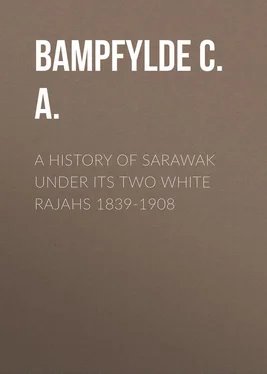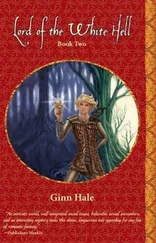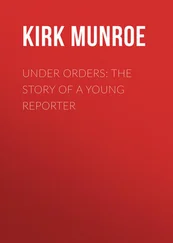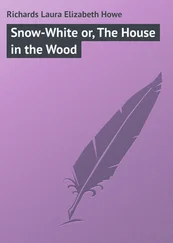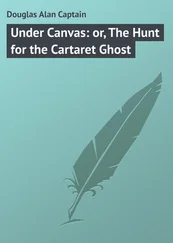C. Bampfylde - A History of Sarawak under Its Two White Rajahs 1839-1908
Здесь есть возможность читать онлайн «C. Bampfylde - A History of Sarawak under Its Two White Rajahs 1839-1908» — ознакомительный отрывок электронной книги совершенно бесплатно, а после прочтения отрывка купить полную версию. В некоторых случаях можно слушать аудио, скачать через торрент в формате fb2 и присутствует краткое содержание. ISBN: , Жанр: foreign_antique, foreign_prose, на английском языке. Описание произведения, (предисловие) а так же отзывы посетителей доступны на портале библиотеки ЛибКат.
- Название:A History of Sarawak under Its Two White Rajahs 1839-1908
- Автор:
- Жанр:
- Год:неизвестен
- ISBN:http://www.gutenberg.org/ebooks/52873
- Рейтинг книги:4 / 5. Голосов: 1
-
Избранное:Добавить в избранное
- Отзывы:
-
Ваша оценка:
- 80
- 1
- 2
- 3
- 4
- 5
A History of Sarawak under Its Two White Rajahs 1839-1908: краткое содержание, описание и аннотация
Предлагаем к чтению аннотацию, описание, краткое содержание или предисловие (зависит от того, что написал сам автор книги «A History of Sarawak under Its Two White Rajahs 1839-1908»). Если вы не нашли необходимую информацию о книге — напишите в комментариях, мы постараемся отыскать её.
A History of Sarawak under Its Two White Rajahs 1839-1908 — читать онлайн ознакомительный отрывок
Ниже представлен текст книги, разбитый по страницам. Система сохранения места последней прочитанной страницы, позволяет с удобством читать онлайн бесплатно книгу «A History of Sarawak under Its Two White Rajahs 1839-1908», без необходимости каждый раз заново искать на чём Вы остановились. Поставьте закладку, и сможете в любой момент перейти на страницу, на которой закончили чтение.
Интервал:
Закладка:
The Kadayans do not appear to be allied to any of the races in N.W. Borneo; those in Sarawak have migrated from Bruni within recent times to escape oppression. They are a peaceful and agricultural race, and many of them are Muhammadans. 26 26 Mr. E. A. W. Cox, formerly Resident of the Trusan, and latterly of the Bintulu, says the Kadayan tradition is that many generations back they were brought from Deli in Sumatra by a former Sultan of Bruni. They have always been the immediate followers of the sultans, forming their main bodyguard. They have no distinctive language of their own, and talk a low Bruni patois; their dress is peculiar; and their system of rice cultivation is far in advance of all other Borneans.
The Muruts and Bisayas are considerable tribes inhabiting the Limbang, Trusan, and Lawas rivers in Sarawak, and beyond. They are of Indonesian stock, and of them a full and interesting account has been given by Sir Spenser St. John in his Life in the Forests of the Far East .
The heads of all these tribes are dolichocephalic or boat-shaped. They are yellow-stained, with hair either straight or slightly waved.
The Land-Dayaks, so named by Europeans in consequence of their not being accustomed to go to sea, or even to the use of boats, either for trading or piratical purposes, number several tribes, with some variations in language. They occupy localities up the rivers Sadong, Samarahan, Sarawak, and Lundu. The remains found among them of Hinduism, such as a stone-shaped bull, 27 27 The Hindu sacred bull.
and other carved monumental stones, and the name of their deity, Jewata, as also the refusal among them to touch the flesh of cattle and deer, and the cremation of their dead, show that they must have been brought into intimate contact with the Hindus, probably at the time when the Hindu-Javanese Empire of Majapahit extended to Borneo. 28 28 Writing of the Rafflesia , "those extraordinary parasitical plants, whose huge and startling conspicuous flowers spring from the ground like gigantic mushrooms," Beccari ( op. cit. p. 102) says, "The Land-Dayaks called the variety he found at Poi (and which he named R. Tuan-Mudæ, in honour of the present Rajah) 'Bua pakma'; evidently a corruption of 'patma' or 'padma,' the sacred lotus ( Nelumbian speciosum ) of the Hindus, which is not a native of Borneo. This is, no doubt, one of the many traces of the ancient faith once professed by the Dayaks, who have preserved the memory of the emblematical flower, transferring its name to that of another plant conspicuous for its size and singular appearance. In Java, as well as in Sumatra, the Rafflesia is known as 'Patma'; but there the fact is not surprising, for the prevalence of Hinduism in those islands is a matter of not very remote history." Pakma or patma is the Malay name for the lotus. The late Sir Hugh Low notes that the Land-Dayaks, who (in common with most of the inland tribes) regulate their farming seasons by the motions of the Pleiades, call that constellation Sakara , probably from the Batara Sakra of the Hindu-Javan mythology, to whose particular care the earth was confided. — Sarawak. Hindu gold ornaments and a Persian coin, bearing a date corresponding with the year 960 A.D., have been discovered up the Sarawak river, and some in the centre of the Land-Dayak country, which shows that the people of the ancient Hindu-Javan settlement at Santubong must have spread into the interior, and have mixed with the natives.
In customs and appearance they differ considerably from the other tribes. They have a tradition that they arrived from the north in large ships, possibly from Siam or Cochin-China. Having been oppressed and persecuted and hunted for their heads by the Sea-Dayaks they have retreated to the tops of hills and rocky eminences.
Of the Land-Dayak Captain the Hon. H. Keppel 29 29 Afterwards Admiral of the Fleet.
says: —
In character he is mild and tractable, hospitable when he is well used, grateful for kindness, industrious, honest, and simple; neither treacherous nor cunning, and so truthful that the word of one of them might safely be taken before the oath of half a dozen Borneans (Malays). In their dealings they are very straightforward and correct, and so trustworthy that they rarely attempt, even after a lapse of years, to evade payment of a just debt. On the reverse of this picture there is little unfavourable to be said, and the wonder is that they have learned so little deceit and falsehood where the examples before them have been so rife.
It is difficult, perhaps impossible now, to assign the position of the Land-Dayaks with regard to the other native peoples. Their language is quite different from the others, and in many other essentials they differ.
Distinct from all these races in physical character and language are the Sea-Dayaks. These are proto-Malays, that is to say they belong to the same ethnic family, but represent that stock in a purer, less mixed stage. Radically their language is the same as the Malay. They are brachycephalic, bullet-headed, with more or less flattened noses, are straight-haired, almost beardless, with skin of olive hue, or the colour of new fallen leaves. They migrated from the west, probably from Sumatra, at a period previous to the conversion of the Malays to Islam, for their language, which with slight dialectic differences, is purely Malay, contains no Arabic except of very recent introduction. The Sea-Dayak inhabits the Batang Lupar, Saribas, Kalaka, and Rejang rivers. They are gradually spreading into the rivers of the north-east, and there are now a good many in the Oya, Muka, Tatau, and Baram districts.
A Sea-Dayak is a clean built man, upright in gait, not tall, the average height being 5 ft. 3 inches. The nose is somewhat flat, the hair straight with no curl in it. The face is generally pleasing from the frankness and good nature that show in it. The women have good figures, light and elastic; well-formed busts, with interesting, indeed often pretty, faces; the skins are, as already stated, of so light a brown as to be almost yellow. They have lustrous dark eyes and black, straight hair.
The Dayaks are very fond of their parents, brothers, sisters, and of their children, and often a strong attachment exists between man and wife that lasts for life. The Dayaks have each but one wife, but it does not follow by any means that the first union lasts. A young couple may find incompatibility of temper after a week or two, and the union is dissolved on the plea of a dream inimical to its continuance.
Incest is considered to be the worst of crimes, bringing a curse on the country. Both incest and bigamy were formerly punishable by a cruel death, now by heavy fines, but for the former offence the fine is far heavier than for the latter.
The Sea-Dayaks are most hospitable, indeed a breach of hospitality is regarded as a punishable offence. They obtained their designation from the English who first came in contact with them, on account of their skill in navigating the sea along the coast, although living inland, and to differentiate them from the Dayaks of Sarawak proper, who were styled Land-Dayaks, because these latter were inexpert boatmen, and very few of them could paddle or swim. As shown farther on, Dayak really signifies an inland man .
The Sea-Dayak is now the dominant race in Sarawak, and in time will become so over the whole of the north-west of Borneo. The spread of this stock in former years appears to have been slow, owing to continual intestine wars, but since the advent of the white man, the discontinuance of these feuds, and the forced adoption of a peaceable life, these people have increased enormously in numbers. Fifty years ago there were but few of them to be found outside the Batang Lupar, Saribas, and Kalaka river-basins, but now, though the population on these rivers has grown considerably, it is less than that of the same race on the Rejang alone, and they are spreading into the Oya, Muka, Tatau, and Baram river-basins. The Melanau population of the two first-named rivers live entirely either on the coast or near to it, and the Dayaks found the upper reaches unoccupied.
Читать дальшеИнтервал:
Закладка:
Похожие книги на «A History of Sarawak under Its Two White Rajahs 1839-1908»
Представляем Вашему вниманию похожие книги на «A History of Sarawak under Its Two White Rajahs 1839-1908» списком для выбора. Мы отобрали схожую по названию и смыслу литературу в надежде предоставить читателям больше вариантов отыскать новые, интересные, ещё непрочитанные произведения.
Обсуждение, отзывы о книге «A History of Sarawak under Its Two White Rajahs 1839-1908» и просто собственные мнения читателей. Оставьте ваши комментарии, напишите, что Вы думаете о произведении, его смысле или главных героях. Укажите что конкретно понравилось, а что нет, и почему Вы так считаете.
